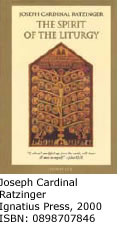| |
|

There is a famous story about some theological divine who was asked early in this century if he was interested in the liturgy. He replied, “No, and I don’t collect stamps, either.” The implication was that liturgy is an aesthetic hobby, and one can take it or leave it; liturgy is not a topic for serious theologians.
I think all would agree that Pope Benedict XVI — Joseph Cardinal Ratzinger when he wrote this book — is a serious theologian. He is serious in the sense of being a good theologian, in the sense of having taught dogmatic theology for 20 years, and for having been the prefect for the Congregation for the Doctrine of the Faith. But this man has written a book about liturgy, and it is a theological book. He gives the lie to the rumor that liturgy belongs with model trains and needlepoint. The book will require some labor by the reader, but it is accessible to the thoughtful person and will reward the effort.
It is divided into four parts, and the range of topics reveals the breadth of Ratzinger’s reading. Part one is “The Essence of the Liturgy.” Ratzinger is concerned to say that “cult embraces the ordering of the whole of human life,” and thus he places liturgy within the matrix of cosmos and history. He traces God’s saving economy from natural religion, through the Old Testament, into the New. Part two is “Time and Space in the Liturgy.” We mark sacred space and sacred time because we live between the “already” and the “not yet.” Ratzinger considers the symbolisms of the Christian Church, including the altar, the ancient symbol of facing east in liturgical prayer, and the tabernacle. He centers his discussion of time around the Christian eighth day and the festal calendar. Part three concerns “Art and Liturgy.” Because the “incarnation is aimed at man’s transformation,” the liturgy has struggled to depict this already occurring in physical form. Here Ratzinger considers the role of both iconography and music, because “when man comes into contact with God, mere speech is not enough.” Part four concerns “Liturgical Form,” the historical ritual forms of the liturgy, and the active participation of the body through signing, posture, gesture, voice, vestment, and material sacrament.
Pope Benedict XVI is at home using concepts and facts from various fields of study, giving the reader a rich background in history and ideas. But he never loses focus on his original intention to use these as brushes with which to paint a theology of the Christian liturgy.
© 2013 Archdiocese of Chicago: Liturgy Training Publications,
3949 South Racine Ave, Chicago IL 60609
|
 |
 |
 |
,
Associate Professor, Department of Theology, University of Notre Dame, and Director, Notre Dame Center for Liturgy, www.liturgy.nd.edu. Works include Theologia Prima and numerous articles in various journals.
|
 |
|
|